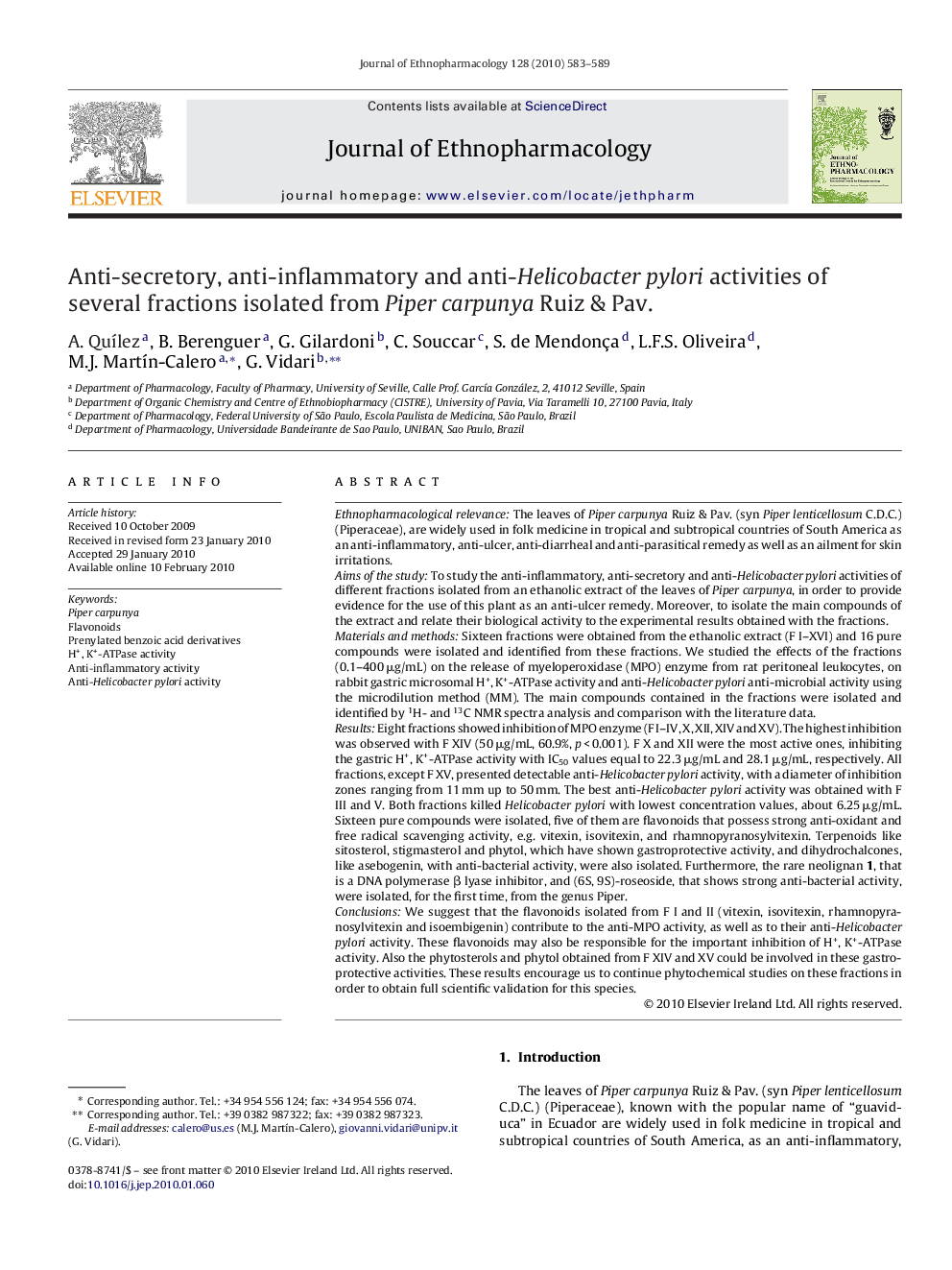| کد مقاله | کد نشریه | سال انتشار | مقاله انگلیسی | نسخه تمام متن |
|---|---|---|---|---|
| 2546497 | 1124028 | 2010 | 7 صفحه PDF | دانلود رایگان |

Ethnopharmacological relevanceThe leaves of Piper carpunya Ruiz & Pav. (syn Piper lenticellosum C.D.C.) (Piperaceae), are widely used in folk medicine in tropical and subtropical countries of South America as an anti-inflammatory, anti-ulcer, anti-diarrheal and anti-parasitical remedy as well as an ailment for skin irritations.Aims of the studyTo study the anti-inflammatory, anti-secretory and anti-Helicobacter pylori activities of different fractions isolated from an ethanolic extract of the leaves of Piper carpunya, in order to provide evidence for the use of this plant as an anti-ulcer remedy. Moreover, to isolate the main compounds of the extract and relate their biological activity to the experimental results obtained with the fractions.Materials and methodsSixteen fractions were obtained from the ethanolic extract (F I–XVI) and 16 pure compounds were isolated and identified from these fractions. We studied the effects of the fractions (0.1–400 μg/mL) on the release of myeloperoxidase (MPO) enzyme from rat peritoneal leukocytes, on rabbit gastric microsomal H+, K+-ATPase activity and anti-Helicobacter pylori anti-microbial activity using the microdilution method (MM). The main compounds contained in the fractions were isolated and identified by 1H- and 13C NMR spectra analysis and comparison with the literature data.ResultsEight fractions showed inhibition of MPO enzyme (F I–IV, X, XII, XIV and XV). The highest inhibition was observed with F XIV (50 μg/mL, 60.9%, p < 0.001). F X and XII were the most active ones, inhibiting the gastric H+, K+-ATPase activity with IC50 values equal to 22.3 μg/mL and 28.1 μg/mL, respectively. All fractions, except F XV, presented detectable anti-Helicobacter pylori activity, with a diameter of inhibition zones ranging from 11 mm up to 50 mm. The best anti-Helicobacter pylori activity was obtained with F III and V. Both fractions killed Helicobacter pylori with lowest concentration values, about 6.25 μg/mL. Sixteen pure compounds were isolated, five of them are flavonoids that possess strong anti-oxidant and free radical scavenging activity, e.g. vitexin, isovitexin, and rhamnopyranosylvitexin. Terpenoids like sitosterol, stigmasterol and phytol, which have shown gastroprotective activity, and dihydrochalcones, like asebogenin, with anti-bacterial activity, were also isolated. Furthermore, the rare neolignan 1, that is a DNA polymerase β lyase inhibitor, and (6S, 9S)-roseoside, that shows strong anti-bacterial activity, were isolated, for the first time, from the genus Piper.ConclusionsWe suggest that the flavonoids isolated from F I and II (vitexin, isovitexin, rhamnopyranosylvitexin and isoembigenin) contribute to the anti-MPO activity, as well as to their anti-Helicobacter pylori activity. These flavonoids may also be responsible for the important inhibition of H+, K+-ATPase activity. Also the phytosterols and phytol obtained from F XIV and XV could be involved in these gastroprotective activities. These results encourage us to continue phytochemical studies on these fractions in order to obtain full scientific validation for this species.
The ethanolic extract of the leaves of Piper carpunya was subjected to column chromatography and 16 pure compounds were isolated and identified. Among these, the terpenoids sitosterol, stigmasterol and phytol as well as the flavonoids vitexin, isovitexin, rhamnopyranosylvitexin and isoembigenin probably contribute to the significant myeloperoxidase, Helicobater pylori and H+, K+-ATPase inhibitory activity observed with many of the fractions. Furthermore, neolignan, which is a DNA polymerase β lyase inhibitor, and (6S, 9S)-roseoside, that shows strong anti-bacterial activity, were isolated, for the first time, from the genus Piper.Figure optionsDownload as PowerPoint slide
Journal: Journal of Ethnopharmacology - Volume 128, Issue 3, 21 April 2010, Pages 583–589